Gibson introduced the new solidbody SG design in the early ’60s because it figured its original Les Paul models were obsolete and needed replacements.
We know now, of course, that Gibson was wrong. But the decision turned out to have great consequences for guitarists today. For not only did Gibson soon reintroduce the original Les Paul design, but also it continued to grow and develop the SG lines. And for some players, an SG can be just as great a catch as a Les Paul.
Gibson has built dozens of different styles of SGs through the decades since, and in this timeline we’ve detailed many of the most important, interesting, and unusual models.

Appearing from the Gibson factory late in 1960, the Standard became a strong focus for the new line. It had a rosewood board with crown markers on mahogany neck, thistle headstock inlay, 22nd fret neck/body join, beveled-edge double-cutaway mahogany body, cherry finish, two humbuckers with regular four-control layout, and “angel-wing” pickguard below pickups. There was a sideways Vibrola trem, then short Vibrola (with ebony block behind the tailpiece), and in 1963 lyre-logo Deluxe Vibrola. At first called Les Paul Standard, with that name on headstock or truss-rod cover (all such models later known as SG/Les Pauls), but by ’63 the model was officially the SG Standard.

The high-end model in the SG line, similar to Standard but ebony board with block markers, white finish, fancy tuners, split-diamond headstock inlay, three humbuckers, gold-plated metalwork. Early models had sideways Vibrola, then short Vibrola (with ebony block behind the tailpiece), and in 1963 lyre-logo Deluxe Vibrola. At first called Les Paul Custom, with that name on small plate between fingerboard and pickup; by 1963, officially SG Custom.

Budget model with regular SG shape, dot markers, 22nd fret neck/body join, P-90 single-coil at bridge, volume, tone, jack on body front, extended angel-wing pickguard, wrapover bridge/tailpiece (optional vibrato). At first called Les Paul Junior, with that name on headstock; by 1963, officially SG Junior. Also SG TV, simply a Junior in yellow, white, or cream given a separate model name.
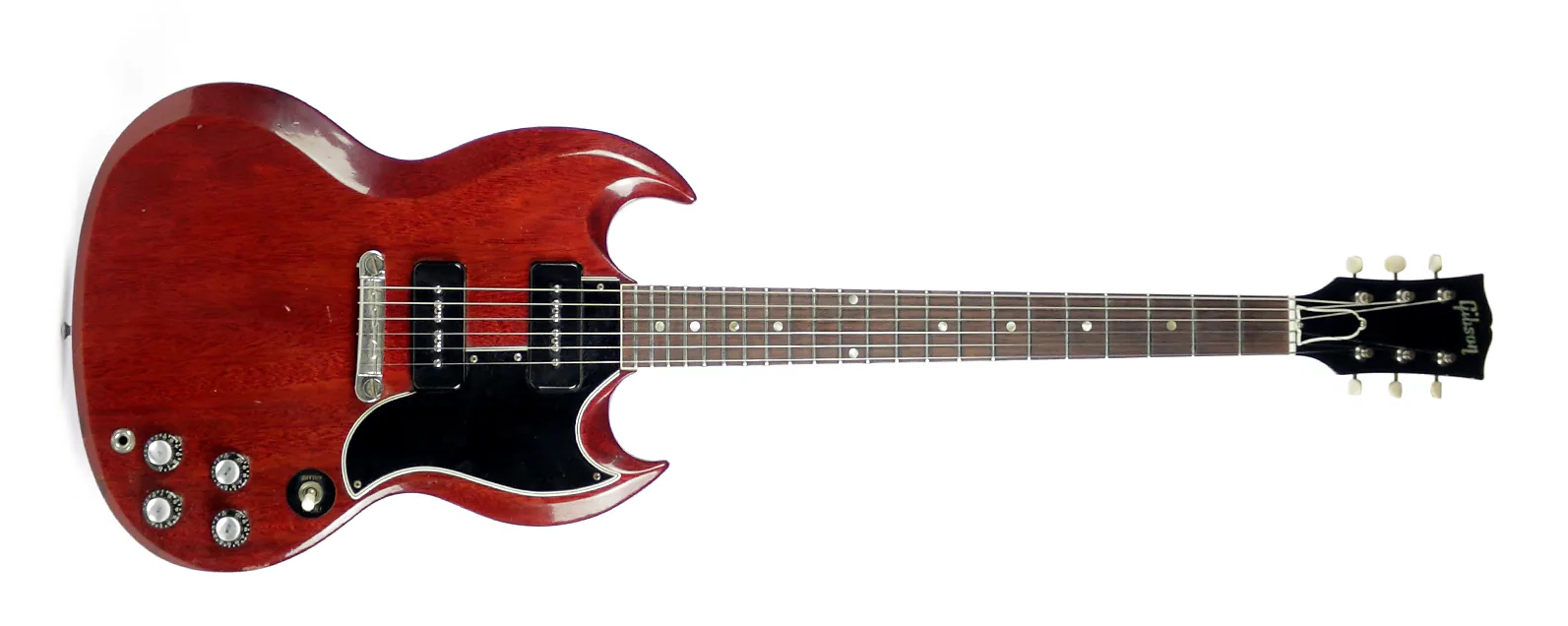
Like Junior but with a pair of P-90s, and sharing Junior’s features and style, including 22nd fret neck/body join and wrapover bridge/tailpiece (vibrato option, standard from ’65).

Into the Norlin era, second Custom type continued high-end vibe and feature set, now with large “bat-wing” pickguard, surrounding pickups. As with other SGs, toward the end of this period Gibson added strengthening lump (“volute”) behind neck-to-headstock junction, slightly reduced headstock tip-back angle, changed regular finish from white to “walnut” (brown).

The Junior (and SG TV, 1966–68) shifted with most SG models in ’66 to bat-wing pickguard and 19th fret neck/body join; standard fitting was short-Vibrola trem.

The Special, too, moved to bat-wing pickguard and 19th fret neck/body join, with standard short-Vibrola trem.
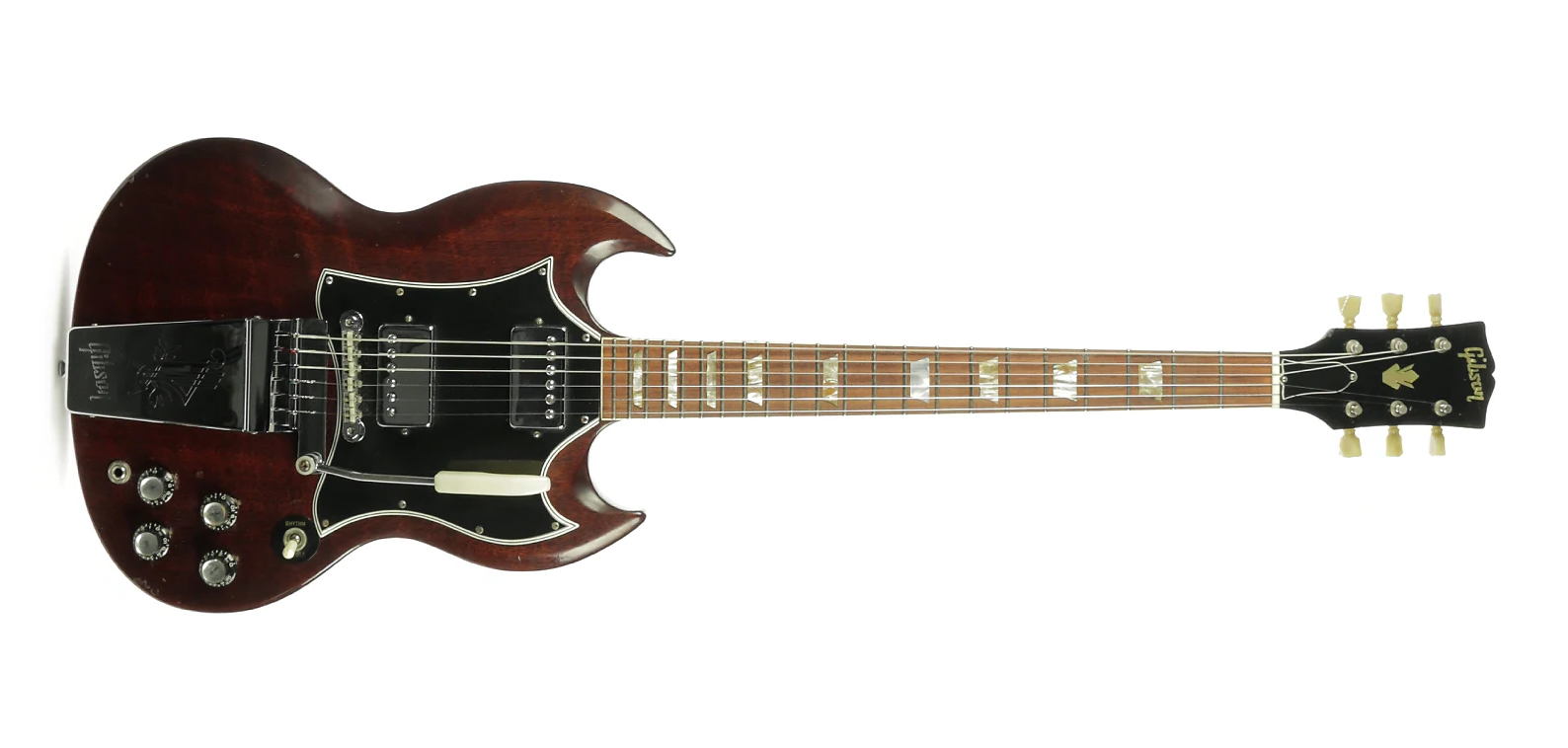
Second Standard type continued general feature set, but now with large bat-wing pickguard and 19th fret neck/body join.
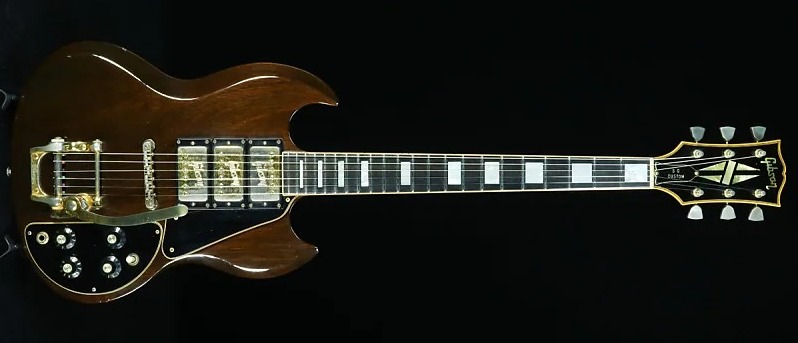
Third style of Custom had controls and jack mounted on semi-circular plate on body front, plus necessary switch to a smaller pickguard; all SGs in this period had changes made to the neck/body layout.

Briefly renamed and re-orientated two-humbucker SG Standard, with small-block markers, controls and jack on semi-circular plate on body front, and Gibson/Bigsby vibrato.
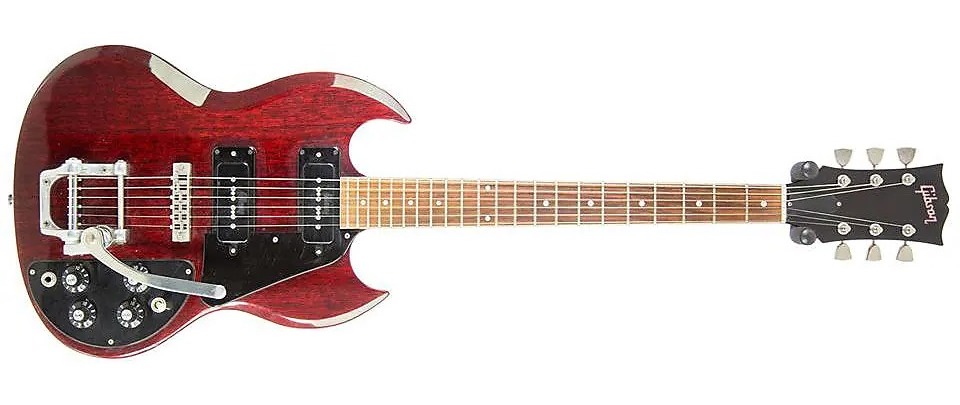
Short-lived renamed and reworked SG Special, with controls and jack on semi-circular plate on body front and Gibson/Bigsby vibrato.
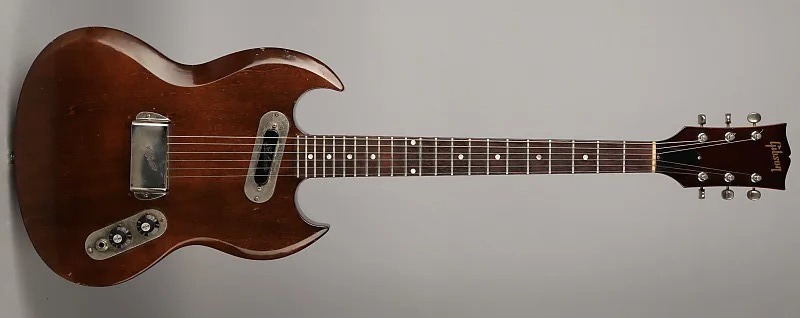
Budget models: Dot markers, one single-coil (100; two on 200, 250), controls and jack on long metal plate on body front, combined bridge/tailpiece. The 250 is sunburst version of 200.
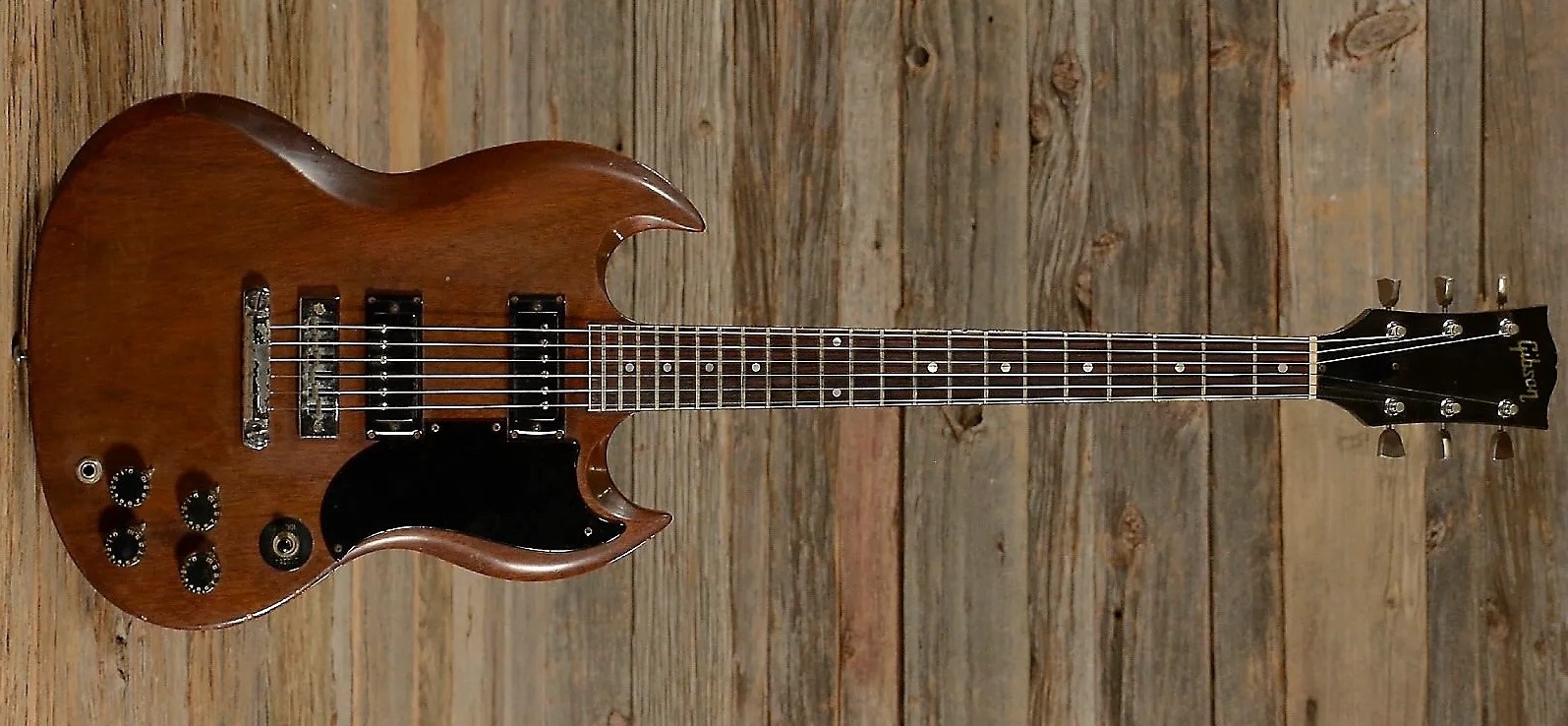
A revived Special following brief diversion to SG Pro, continuing with two mini-humbuckers, bridge-plus-stopbar (vibrato option), dot markers became small blocks in ’73.

After short-lived detour to SG Deluxe, this revived Standard had small-block markers (crowns again from 1985), some ebony fingerboards, angel-wing pickguard, and bridge-plus-stopbar (vibrato option). In 1980, jack moved to edge of body and pickup switch above knobs.

Budget models replacing SG-100/200/250: Dot markers, mini-humbucker (I; two on II, III), controls and jack on semi-circular plate on body front, wrapover bridge/tailpiece.
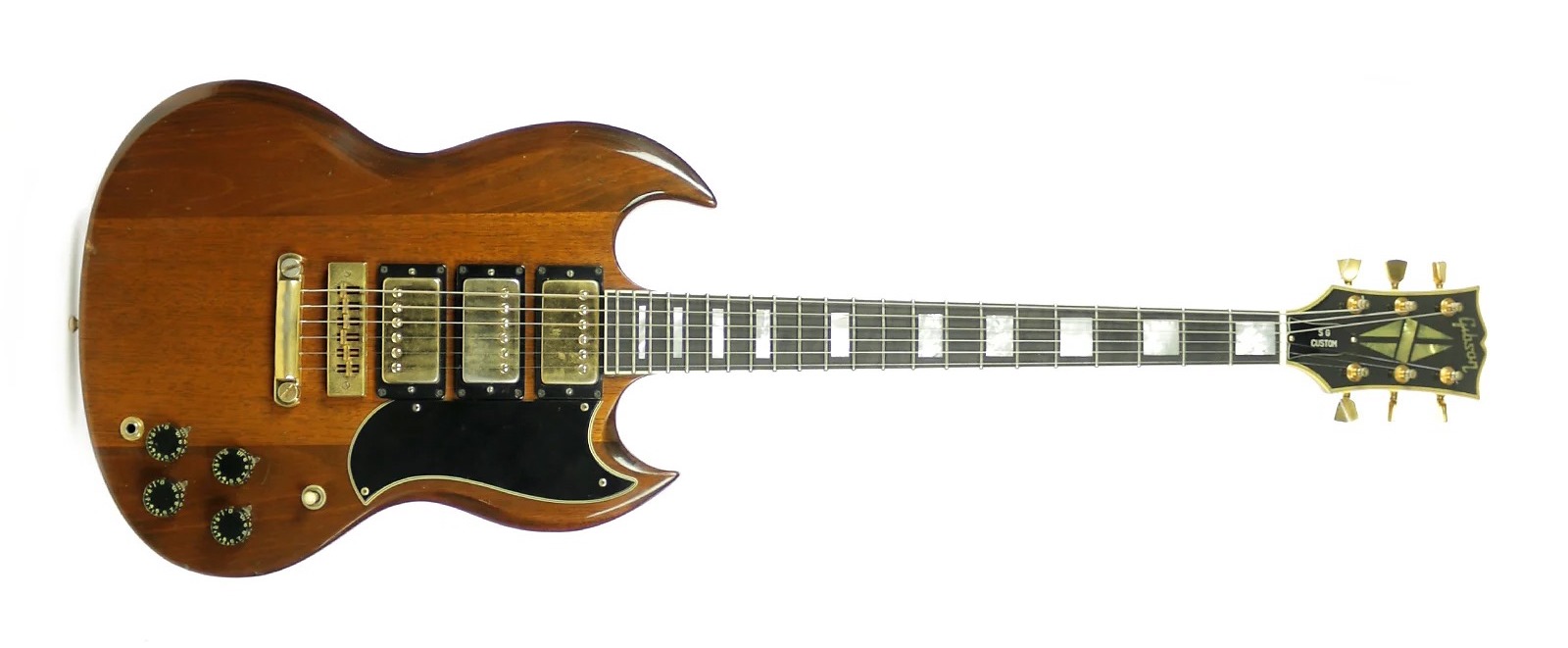
Still in the Norlin era, this fourth type had some of Custom’s traditional look, returning to body-mounted controls and jack, original-style pickguard. SG production shifted mid ’70s to Gibson’s new Nashville factory.
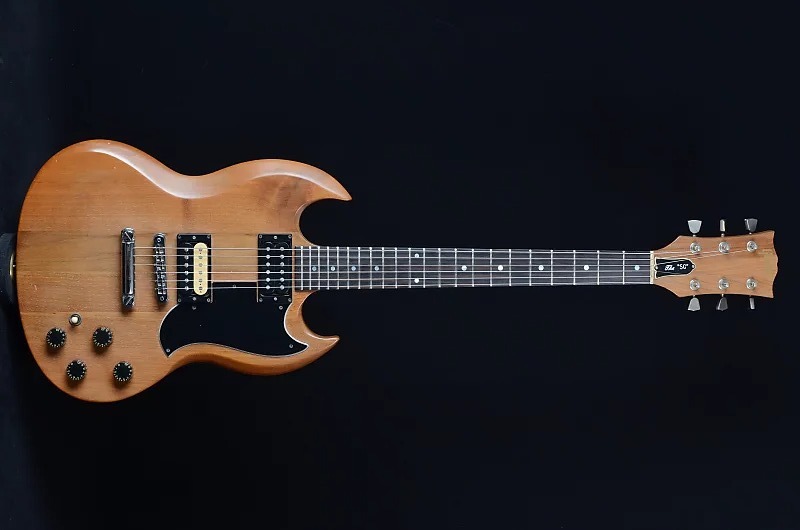
Budget model: Walnut neck and body, ebony fingerboard (some rosewood), two coverless humbuckers; also known as The SG Standard. Similar The SG Deluxe (1980–85) with mahogany neck and body. Some with “branded” headstock logo, also known as The SG Firebrand.
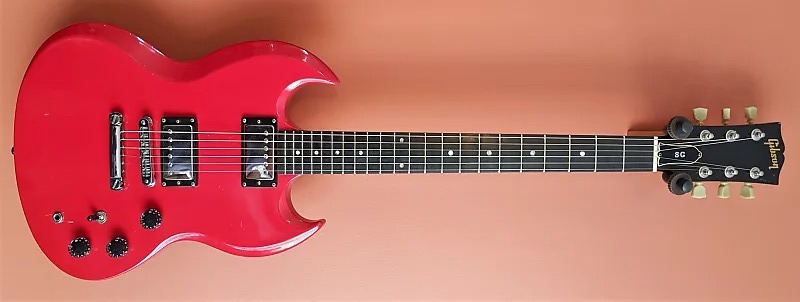
The ’80s version had maple neck, some bodies alder or poplar, two humbuckers, three knobs (two volume, one tone), no pickguard. Known at first as Special II (1983–85) alongside single-pickup two-controls Special I (1983–84).

Gibson re-created early styles with SG ’62 Custom (1986–87) and SG/Les Paul Custom (1987–93), while 1967 SG Custom (1991–93) was reissue of the bat-wing period. All were bridge-plus-stopbar models, shunning period-correct vibratos.
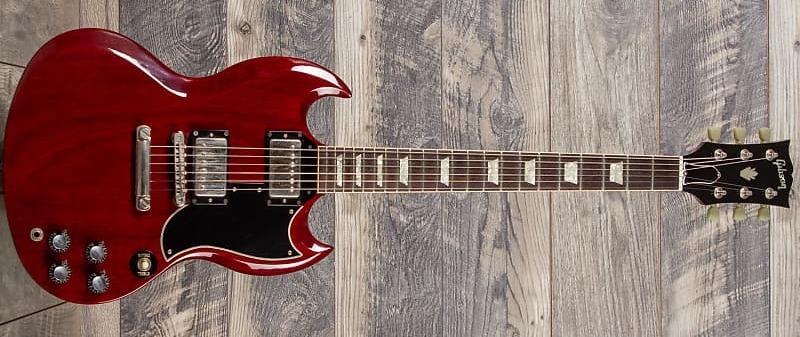
With or without the Les Paul name on the guitar, the early-period reissue has had a variety of official names through the years, including SG 62, SG Reissue, Les Paul SG ’61 Reissue, SG 61, and SG Original. (Latest version, SG Standard ’61, see SG Standard, 2019–current.)
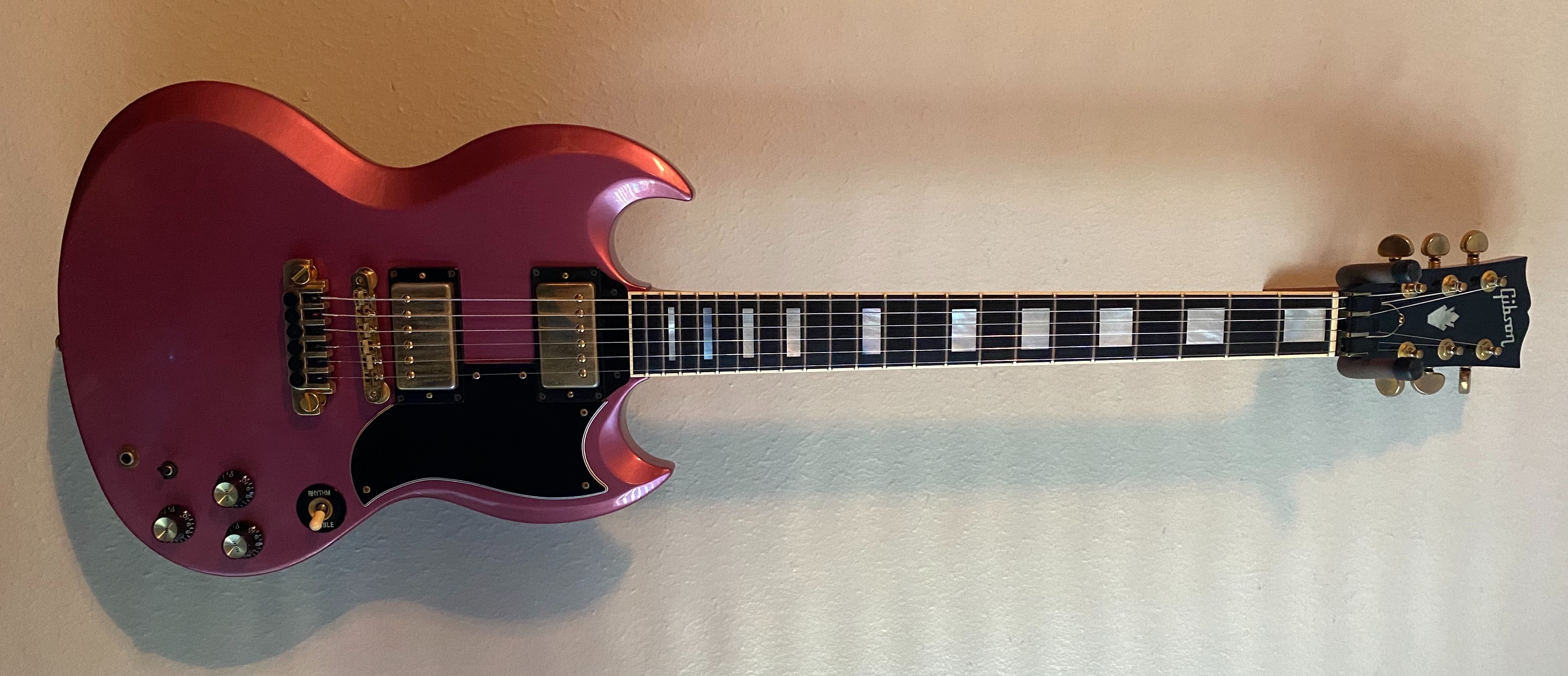
Fancy Custom-like ’80s model: Block markers, locking nut, two humbuckers, three knobs, coil-tap, fine-tuning tailpiece, gold-plated metalwork.

Attempt at ’80s features in relatively budget package: 25.5-inch scale, 24 frets, coverless humbucker (Single; Double adds single-coil at bridge), coil-tap, pearloid pickguard, strings-through-body for hardtail (or locking vibrato option).
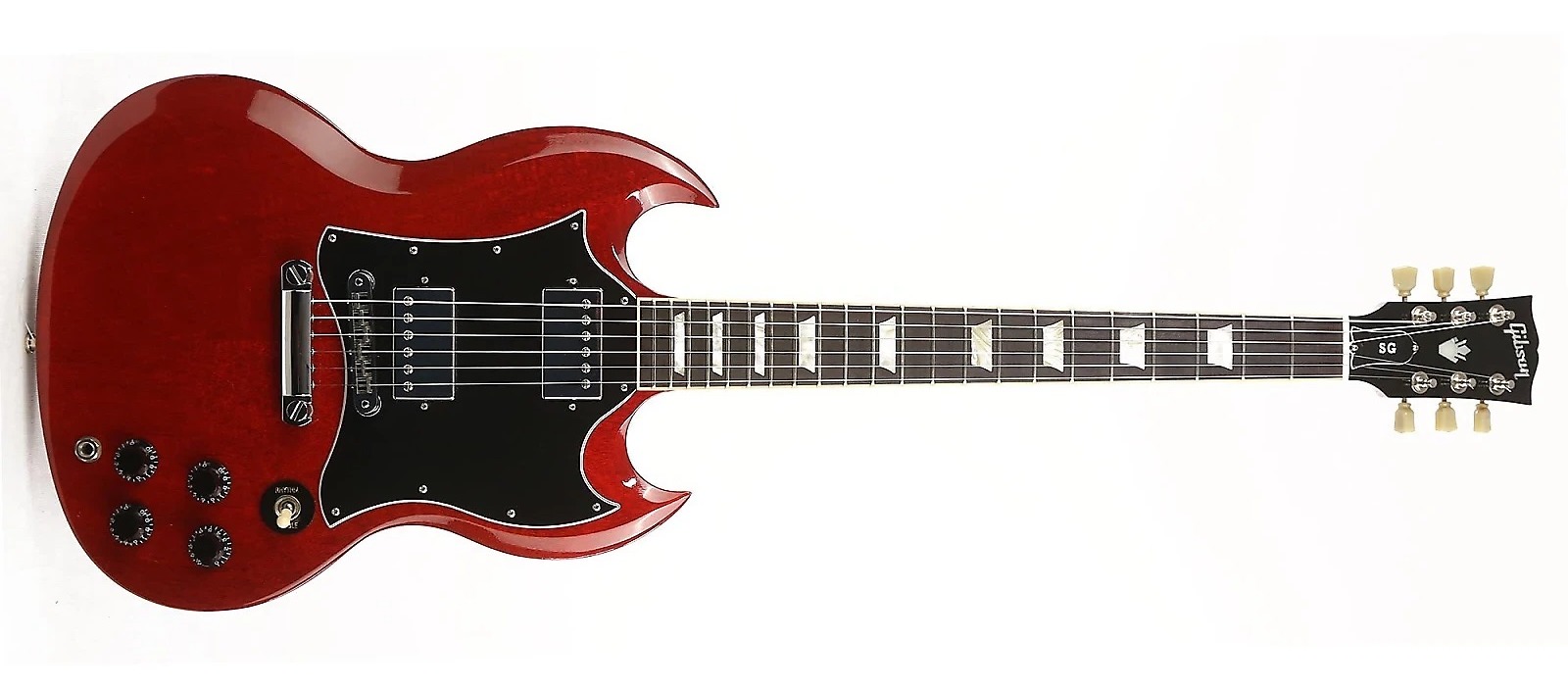
A revised look for Standard, with crown markers and bat-wing pickguard, pickup switch returned to original position near pickguard and jack returned to body front.
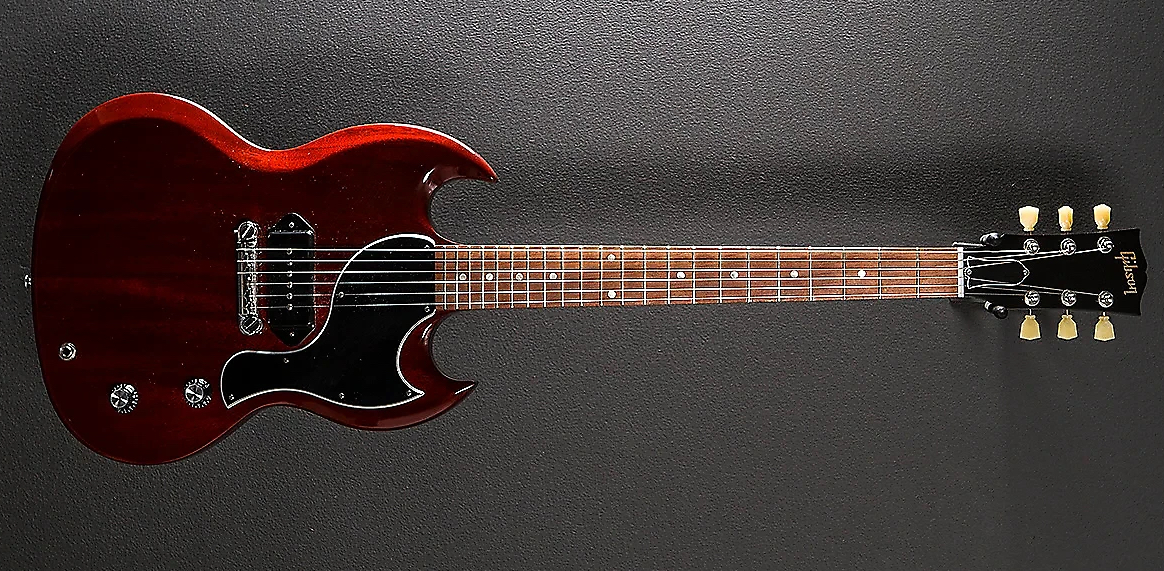
Gibson re-created classic Junior at various times, with original-style pickguard (1991-94, 2011–12) or bat-wing type (2000–01), and with bridge-plus-stopbar (1991-94) or wrapover bridge/tailpiece (2000–01, 2011–12). (Latest version see SG Junior, 2019–current.)
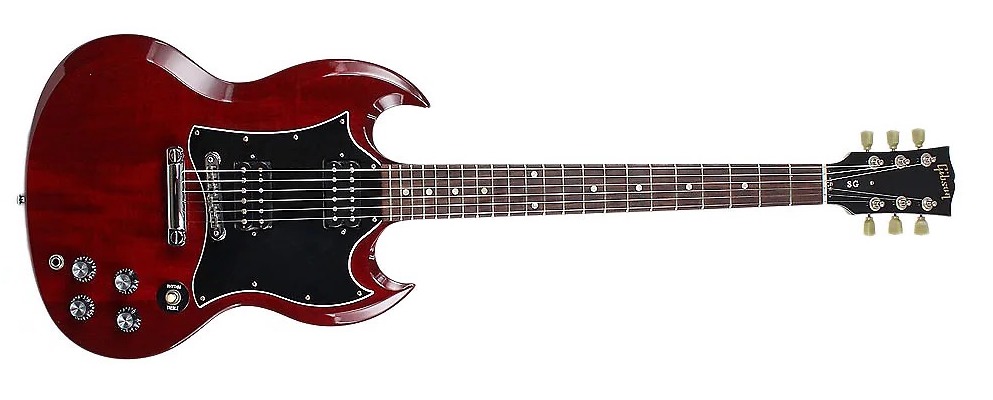
The Special returned to regular four-knob control layout, with two coverless humbuckers, bat-wing pickguard, bridge-plus-stopbar. (Latest version see SG Tribute, 2019–current.) Also SG Special Faded (2002–11) with Gibson’s aged-look thin nitro finish. Similar SG Special Raw Power (2009–11) had maple neck and body.
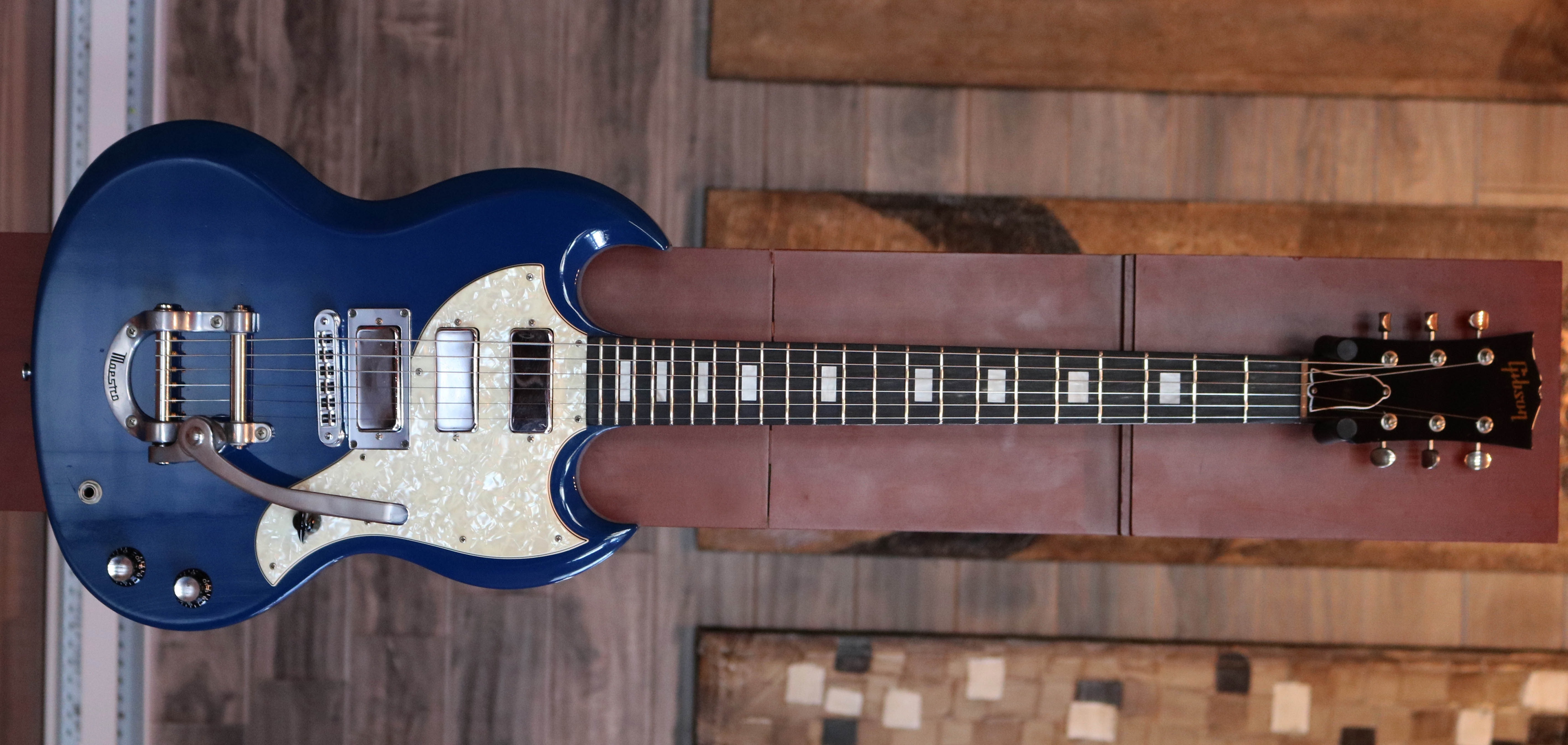
Mashup design with dot markers (at first small blocks), three mini-humbuckers, two knobs, pickup six-way on pickguard, Maestro/Bigsby vibrato.
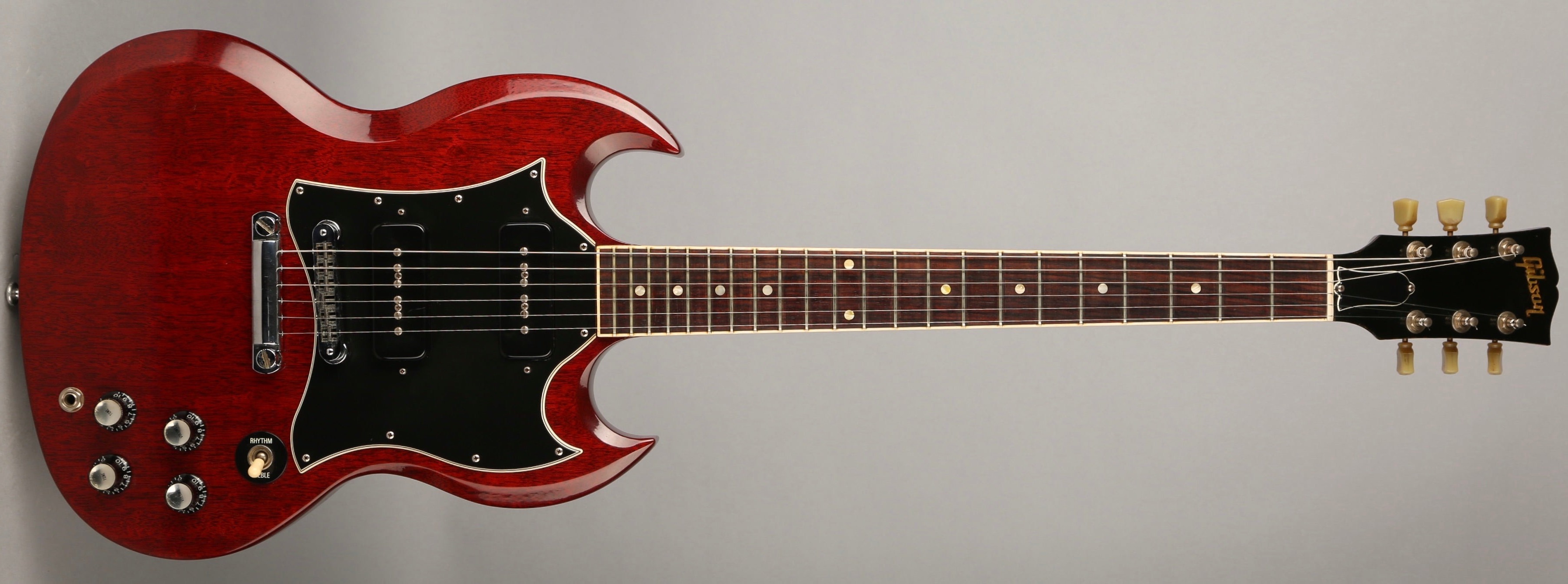
Late-’60s-Special style: Dot markers, two P-90s, bat-wing pickguard, bridge-plus-stopbar.
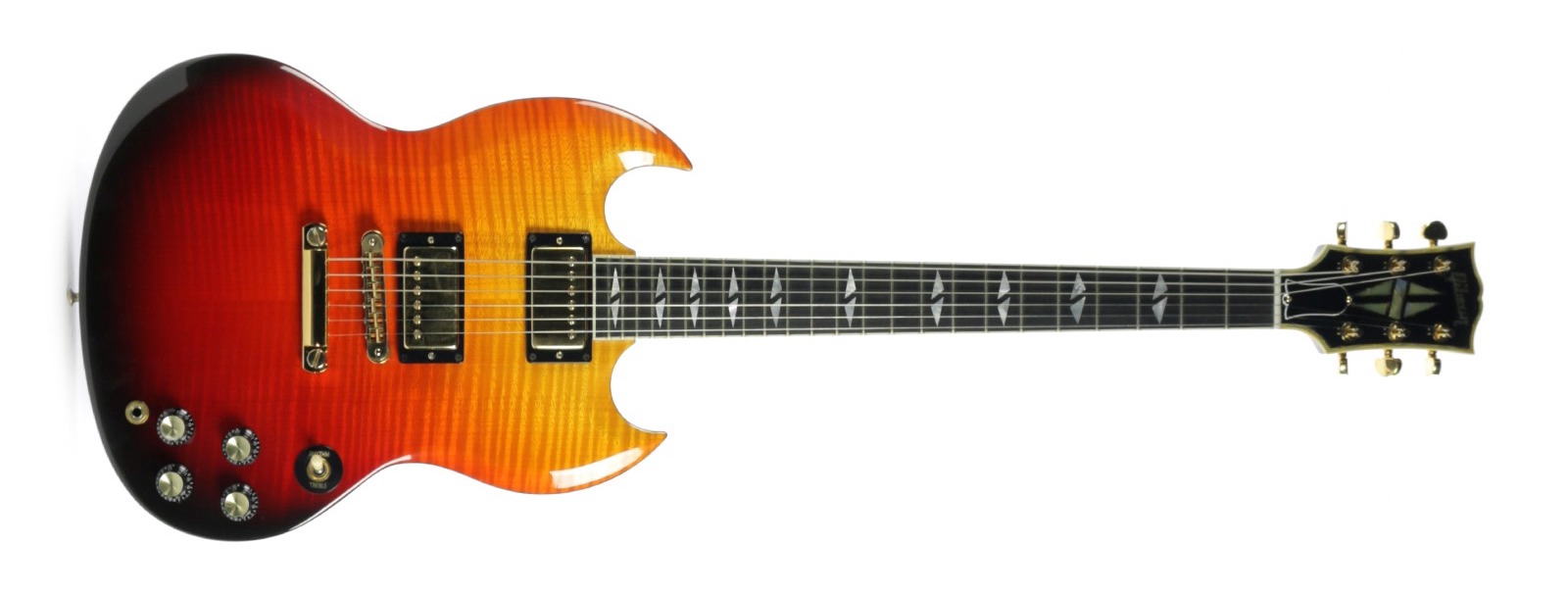
Fancy high-end model: Split-diamond inlays, figured maple top on mahogany body, two humbuckers (early models two P-90s), no pickguard, gold-plated metalwork (some chrome).

Fancy Custom-like model: Split-diamond markers and headstock inlay, figured maple top on mahogany body, three humbuckers, no pickguard, Bigsby vibrato.

Four Tribute models with no pickguard, optional Min-ETune tuning: Two P-90s (Tribute ’50s); two humbuckers (Tribute ’60s); two coverless humbuckers (Tribute ’70s); two coverless humbuckers, 24 frets, forward-facing banjo tuners (Tribute Future). Later (different) model see SG Tribute, 2019–current.

Budget model: Maple neck, dot markers, 24 frets (“120th anniversary” at 12th fret, 2014), two humbuckers (coverless 2014), no pickguard. Similar SGM (2014) with Min-ETune tuning.

Features vary with model year: 22nd fret neck/body join, angel-wing pickguard (2013); “120th” logo at 12th fret (2014); “Les Paul 100” signature at headstock, G Force tuning, no pickguard (2015).

Features vary with model year: Two humbuckers, “120th” logo at 12th fret (2014); two coverless humbuckers, “Les Paul 100” signature at headstock, no pickguard, G Force tuning (2015).

SG Special T features vary with model year: Maple neck, small-block markers, two mini humbuckers (2016); 24 frets, two humbuckers (2017); 24 frets, two mini humbuckers (2018). Similar SG Special HP (2016–17) with G Force tuning, zero-fret nut, contoured heel, 22nd fret neck/body join. Also SG Special Faded T (2016–17), plus similar SG Special Faded HP (2016–17) with Gibson’s aged-look thin nitro finish, G Force tuning, zero-fret nut, contoured heel, covered humbuckers.
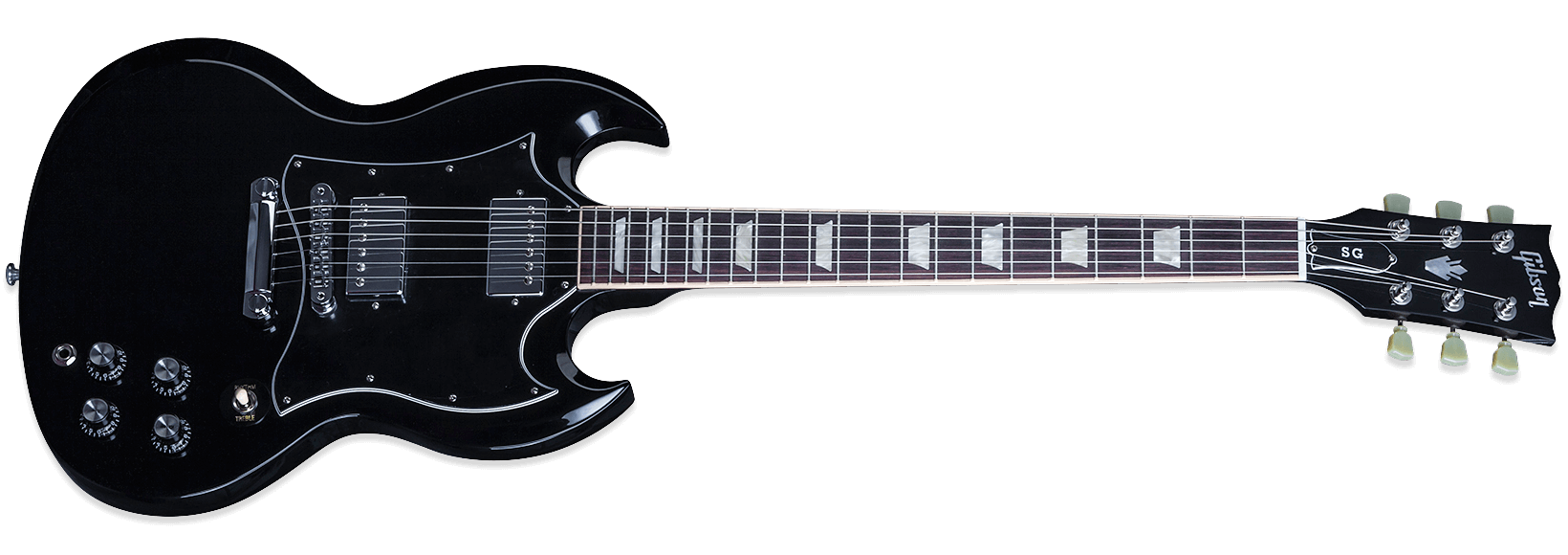
Features vary with model year. SG Standard T: 19th fret neck/body join; bat-wing pickguard (2016); 19th fret neck/body join, angel-wing pickguard (2017–18). Similar SG Standard HP: G Force tuning, zero-fret nut, contoured heel, 22nd fret neck/body join (2016–17); 24 frets, some with G Force tuning, mahogany body with figured maple top, no pickguard (2018). The 2018 HP version was renamed SG Modern (2019–current).

Under a new owner, Gibson simplified and settled its model lines, including the SGs. This classic Junior, in Gibson’s Original series, has dot markers, 22nd fret neck/body join, one P-90, extended angel-wing pickguard, and wrapover bridge/tailpiece.

Today’s classic-look Original-series Special has dot markers, 22nd fret neck/body join, two P-90s, angel-wing pickguard, wrapover bridge/tailpiece. Also SG Tribute (2019–current, also known as SG Standard Tribute) in Gibson’s Modern series, with dot markers, 19th fret body join, two coverless humbuckers, bat-wing pickguard, bridge-plus-stopbar.

The classic Standard in Gibson’s Original series is the SG Standard ’61, with crown markers, 22nd fret neck/body join, two humbuckers, angel-wing pickguard, bridge-plus-stopbar (also vibrato versions: SG Standard '61 Sideways Vibrola or SG Standard '61 Maestro Vibrola). Also SG Standard (2019–current) in Modern series with 19th fret neck/body join, two humbuckers, bat-wing pickguard, bridge-plus-stopbar.
About the author: Tony Bacon writes about musical instruments, musicians, and music. His books include The SG Guitar Book and Legendary Guitars. Tony lives in Bristol, England. More info at tonybacon.co.uk.
